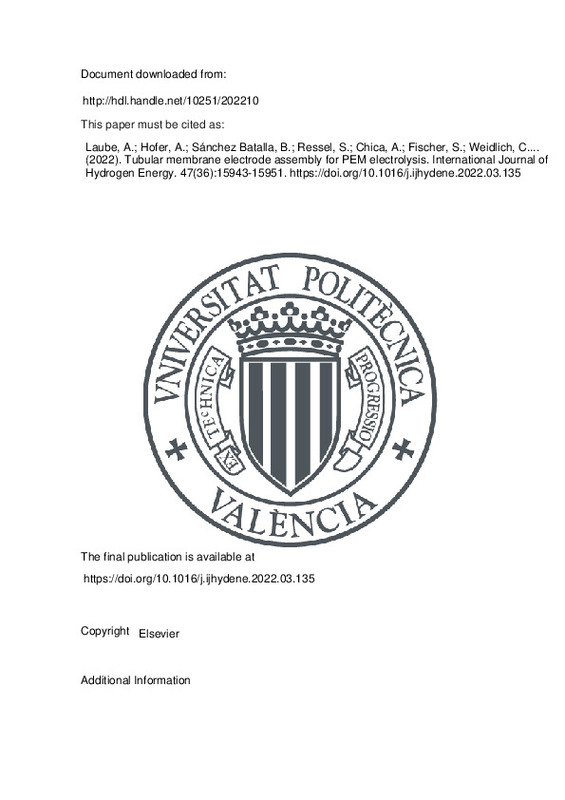JavaScript is disabled for your browser. Some features of this site may not work without it.
Buscar en RiuNet
Listar
Mi cuenta
Estadísticas
Ayuda RiuNet
Admin. UPV
Tubular membrane electrode assembly for PEM electrolysis
Mostrar el registro sencillo del ítem
Ficheros en el ítem
| dc.contributor.author | Laube, A.
|
es_ES |
| dc.contributor.author | Hofer, A.
|
es_ES |
| dc.contributor.author | Sánchez Batalla, B.
|
es_ES |
| dc.contributor.author | Ressel, S.
|
es_ES |
| dc.contributor.author | Chica, Antonio
|
es_ES |
| dc.contributor.author | Fischer, S.
|
es_ES |
| dc.contributor.author | Weidlich, C.
|
es_ES |
| dc.contributor.author | Bachmann, J.
|
es_ES |
| dc.contributor.author | Struckmann, T.
|
es_ES |
| dc.date.accessioned | 2024-01-29T19:01:30Z | |
| dc.date.available | 2024-01-29T19:01:30Z | |
| dc.date.issued | 2022-04-29 | es_ES |
| dc.identifier.issn | 0360-3199 | es_ES |
| dc.identifier.uri | http://hdl.handle.net/10251/202210 | |
| dc.description.abstract | [EN] Polymer electrolyte membrane (PEM) water electrolysis is already widely used for hydrogen production but still needs further cost reductions. While tubular cell designs might reduce production costs by extrusion production of cell components and small sealing lengths, catalyst coating methods like atomic layer deposition (ALD) might reduce catalyst costs significantly. This study demonstrates the feasibility of a tubular PEM electrolyzer membrane electrode assembly (MEA) for the oxygen half cell with 5.0 mm diameter. An extruded perfluorosulfonic acid (PFSA) cation exchange membrane is combined with a porous transport electrode (PTE) consisting of a titanium felt with a low iridium catalyst loading obtained by ALD. The performance is experimentally characterized in a complete tubular cell setup by polarization curve and ohmic resistance measurements. Operation in sulphuric acid at a cell voltage of 1.7 V and a cell temperature of 60 °C results in an overall current density of 55 mA cm¿1 and an iridium mass activity 680 A g¿1 which is up to 3 times larger than literature values. The high frequency ohmic resistance of the cell turns out to be 0.96 ¿ cm¿2. Up to the knowledge of the authors, this is the first time, that a tubular PEM electrolysis cell is designed, assembled and characterized. | es_ES |
| dc.description.sponsorship | This work was done within the research project Tubulyze and was supported by the German Federal Ministry of Education and Research (BMBF FKZ: 03FS0564B). | es_ES |
| dc.language | Inglés | es_ES |
| dc.publisher | Elsevier | es_ES |
| dc.relation.ispartof | International Journal of Hydrogen Energy | es_ES |
| dc.rights | Reconocimiento - No comercial - Sin obra derivada (by-nc-nd) | es_ES |
| dc.subject | Cylindric cell design | es_ES |
| dc.subject | PEM water Electrolysis | es_ES |
| dc.subject | ALD catalyst Coating | es_ES |
| dc.subject | Porous transport electrodes | es_ES |
| dc.title | Tubular membrane electrode assembly for PEM electrolysis | es_ES |
| dc.type | Artículo | es_ES |
| dc.identifier.doi | 10.1016/j.ijhydene.2022.03.135 | es_ES |
| dc.relation.projectID | info:eu-repo/grantAgreement/BMBF//03FS0564B//Tubulyze/ | es_ES |
| dc.rights.accessRights | Abierto | es_ES |
| dc.contributor.affiliation | Universitat Politècnica de València. Instituto Universitario Mixto de Tecnología Química - Institut Universitari Mixt de Tecnologia Química | es_ES |
| dc.description.bibliographicCitation | Laube, A.; Hofer, A.; Sánchez Batalla, B.; Ressel, S.; Chica, A.; Fischer, S.; Weidlich, C.... (2022). Tubular membrane electrode assembly for PEM electrolysis. International Journal of Hydrogen Energy. 47(36):15943-15951. https://doi.org/10.1016/j.ijhydene.2022.03.135 | es_ES |
| dc.description.accrualMethod | S | es_ES |
| dc.relation.publisherversion | https://doi.org/10.1016/j.ijhydene.2022.03.135 | es_ES |
| dc.description.upvformatpinicio | 15943 | es_ES |
| dc.description.upvformatpfin | 15951 | es_ES |
| dc.type.version | info:eu-repo/semantics/publishedVersion | es_ES |
| dc.description.volume | 47 | es_ES |
| dc.description.issue | 36 | es_ES |
| dc.relation.pasarela | S\464839 | es_ES |
| dc.contributor.funder | Bundesministerium für Bildung und Forschung, Alemania | es_ES |







![[Cerrado]](/themes/UPV/images/candado.png)

